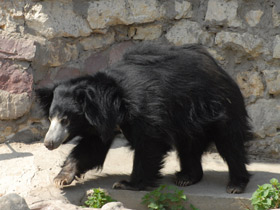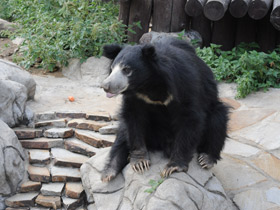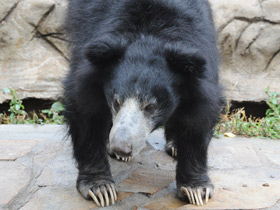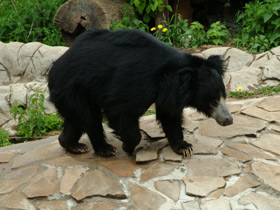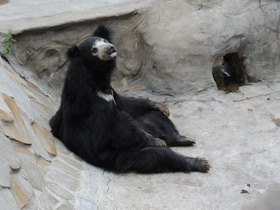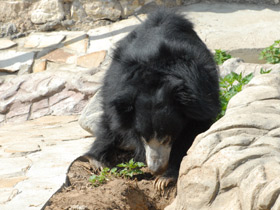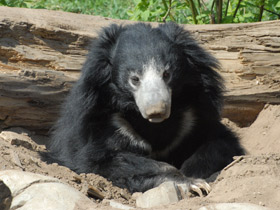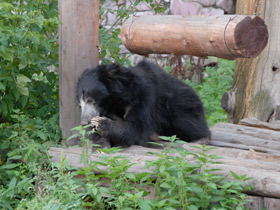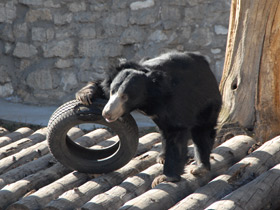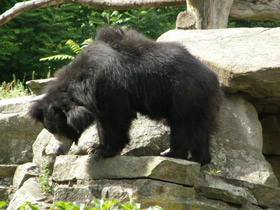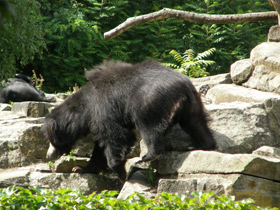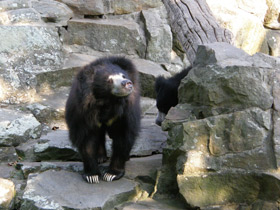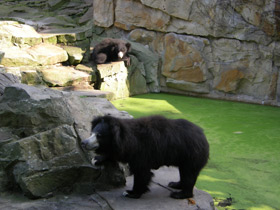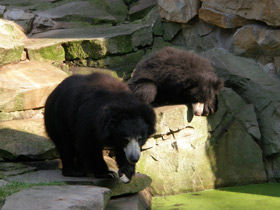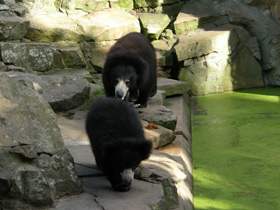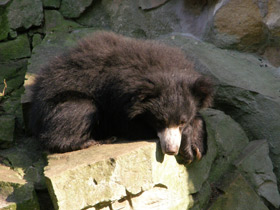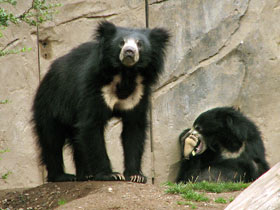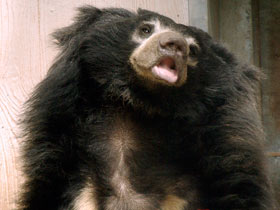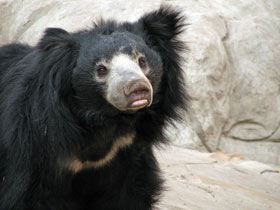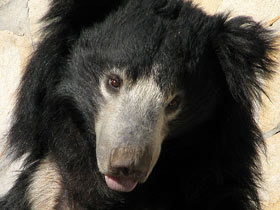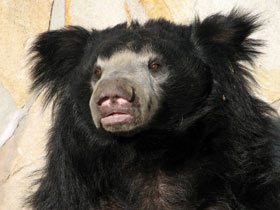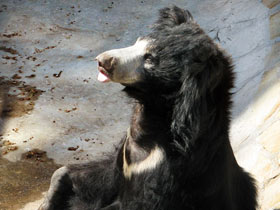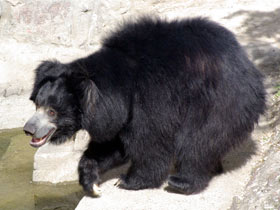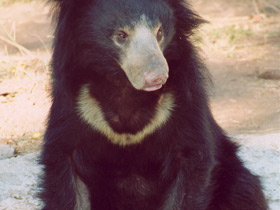The sloth bear or the Indian bear (Melursus ursinus)
The sloth bear (Melursus ursinus), also known as the Indian bear, is a myrmecophagous bear species native to the Indian subcontinent. It feeds on fruits, ants and termites. It is listed as vulnerable on the IUCN Red List, mainly because of habitat loss and degradation. It is the only species in the genus Melursus.
It has also been called "labiated bear" because of its long lower lip and palate used for sucking up insects. It has long, shaggy fur, a mane around the face, and long, sickle-shaped claws. It is lankier than brown and Asian black bears. It shares features of insectivorous mammals and evolved during the Pleistocene from the ancestral brown bear through divergent evolution.
Sloth bears breed during spring and early summer and give birth near the beginning of winter. When their territories are encroached upon by humans, they sometimes attack them. Historically, humans have drastically reduced these bears' habitat and diminished their population by hunting them for food and products such as their bacula and claws. Sloth bears have been tamed and used as performing animals and as pets.
Taxonomy
George Shaw in 1791 named the species Bradypus ursinus. In 1793, Meyer named it Melursus lybius, and in 1817, de Blainville named it Ursus labiatus because of its long lips. Illiger named it Prochilus hirsutus, the Greek genus name indicating long lips, while the specific name noted its long and coarse hair. Fischer called it Chondrorhynchus hirsutus, while Tiedemann named it Ursus longirostris.
Description and nutrition
Melursus ursinus is a species of carnivorous mammal of the Ursidae family.
The Latin name Melursus ('honey bear') is given to this amazing animal because of its love of honey. It climbs trees up to a height of 10 metres and is even willing to endure bee stings in order to eat their honeycombs.
The general appearance of Melursus ursinus is typically bear-like: massive body on strong legs, large head with flat forehead (photo 1, 2, 3, 4).
However, it differs so much from real bears that it has been divided into a separate genus. The fact is that this predator has a number of unique adaptations that allow it to feed very effectively on colonial insects.
Its large sickle-shaped claws are adapted for climbing trees, digging and destroying termites. Unlike other bears, the snout is almost hairless, and the lips are extremely flexible and able to stretch greatly to form a tube (which was the basis for the species name) (photos 6 and 7).
In addition, Melursus ursinus has a very long tongue, does not have two upper front incisors and can arbitrarily close its nostrils (to prevent insects from getting in). The result is an amazing tool, which looks a bit like an anteater's trunk, but works on the principle of a vacuum pump. Melursus ursinus uses such a sophisticated device to collect termites and ants. After finding a termite mound, it destroys its wall with its powerful claws, expels dust and dirt and then, like a hoover, sucks up its prey through its extended lips.
In addition to termites, the bear also eats other insects and their larvae, as well as snails, eggs, various fruits, flowers, leaves and rhizomes of plants, and often ravages sugar cane and corn fields. From March to June, when fruits ripen, they may constitute up to 50% of the diet of Melursus ursinus.
Distribution and habitat
The sloth bear's global range includes India, the Terai of Nepal, temperate climatic zones of Bhutan and Sri Lanka. It occurs in a wide range of habitats including moist and dry tropical forests, savannahs, scrublands and grasslands below 1,500 m (4,900 ft) on the Indian subcontinent, and below 300 m (980 ft) in Sri Lanka's dry forests. It is regionally extinct in Bangladesh.
Behaviour and ecology
Adult sloth bears may travel in pairs. Males are often observed to be gentle with cubs. They may fight for food. They walk in a slow, shambling motion, with their feet being set down in a noisy, flapping motion. They are capable of galloping faster than running humans. Although they appear slow and clumsy, both young and adult sloth bears are excellent climbers. They occasionally will climb to feed and to rest, though not to escape enemies, as they prefer to stand their ground. Sloth bear mothers carry their cubs up trees as the primary defense against attacks by predators instead of sending them up trees. The cubs can be threatened by predators such as tigers, leopards, and other bears. They are adequate climbers on more accessible trees but cannot climb as quickly or on as varied surfaces as can black bears due to the sloth species' more elongated claw structure. Given their smaller size and still shorter claws, sloth bear cubs probably climb more proficiently than adults (much as brown bear cubs can climb well but not adults). They are good swimmers, and primarily enter water to play.
To mark their territories, sloth bears scrape trees with their forepaws, and rub against them with their flanks. Sloth bears are recorded to produce several sounds and vocals. Howls, squeals, screams, barks and trumpet-like calls are made during aggressive encounters while huffing is made as a warning signal. Chuffing calls are made when disturbed. Females keep in contact with their cubs with a grunt-whicker while cubs yelp when separated.
Reproduction and peculiarities
The young (1-2, rarely 3) are born in a burrow, cave or shelter under rocks. Although the young have strong toes, they are very small and defenceless. Their eyes open at around three weeks of age and they cannot walk on their own until they are one month old. Sometimes the male also takes care of his cubs for the first time, which is not typical for bears. Two to three months after birth, the cubs leave the den and usually travel on their mother's back. This way of travelling - which, by the way, is not found in other bears - is preserved even when the cubs have matured and cannot fit together on the mother's back: they then alternately sit on her back or run alongside her. Cubs remain with their mother until they are two or three years old.
Conservation status
Melursus ursinus is included in the IUCN Red List as endangered.
Subspecies and range
- Indian sloth bear (Melursus ursinus ursinus)
- This is the nominate subspecies and has a large skull with a condylobasal length of about 290 mm (11 in) in females and about 310 mm (12 in) in males.
- The sloth bear is the most widespread bear species in India, where it mostly occurs in areas with forest cover, low hills bordering the outer range of the Himalayas from Punjab to Arunachal Pradesh. It is absent in the high mountains of Himachal Pradesh and Jammu and Kashmir, the northwestern deserts of Rajasthan, and a broad unforested swath in the south, where Mount Abu Wildlife Sanctuary is located. Sloth bear occurs in protected areas such as Shoolpaneshwar, Ratanmahal, Jessore, and Balaram Ambaji Sanctuaries.
- In Nepal, it is restricted to the Terai.
- Sri Lankan sloth bear (Melursus ursinus inornatus)
- The Sri Lankan sloth bear is smaller than the nominate subspecies, has a smaller skull with a condylobasal length of about 250 mm (9.8 in) in females and about 264 mm (10.4 in) in males. It has much shorter body hair, and sometimes lacks the characteristic white chest mark.
- At the turn of the century, the Sri Lankan sloth bear occurred throughout Sri Lanka. But due to wide-scale conversion of upland forests into tea and coffee plantations, it is now restricted to the northern and eastern lowlands.

















